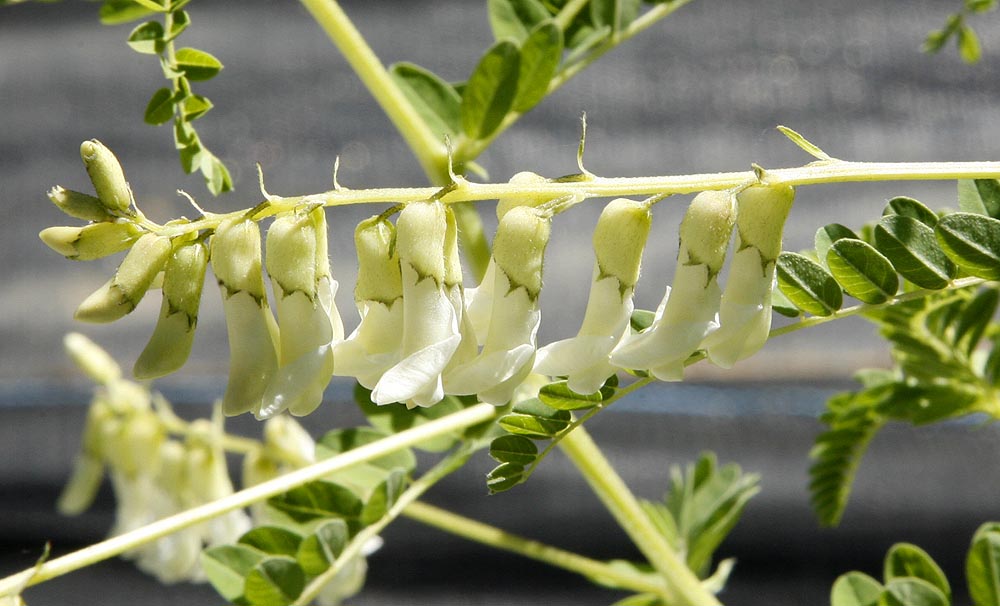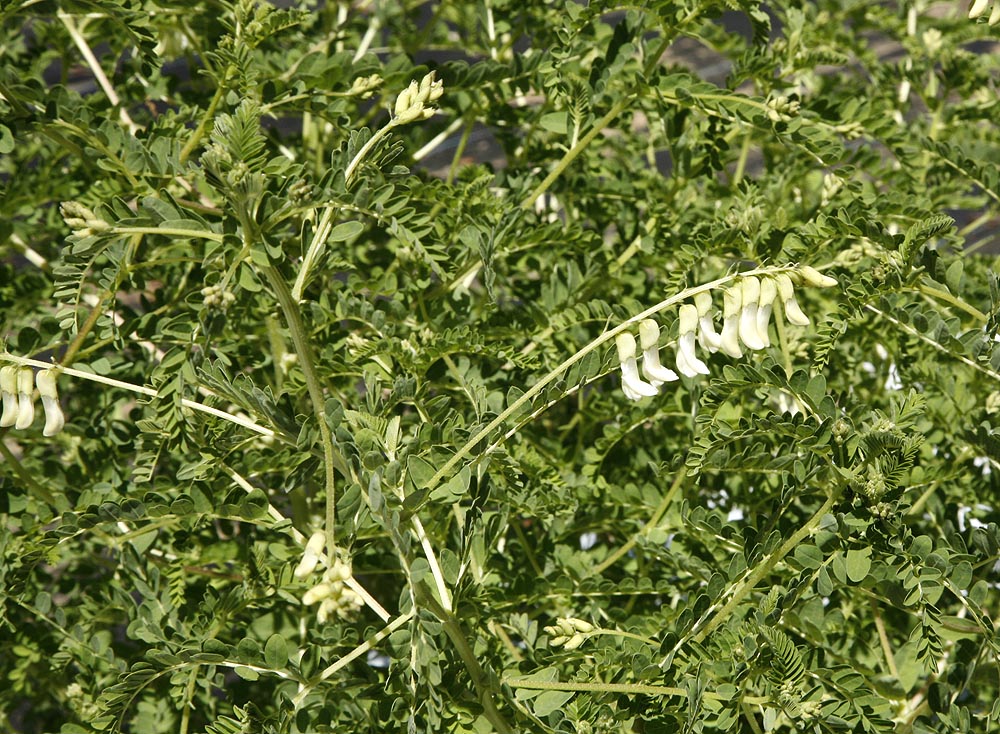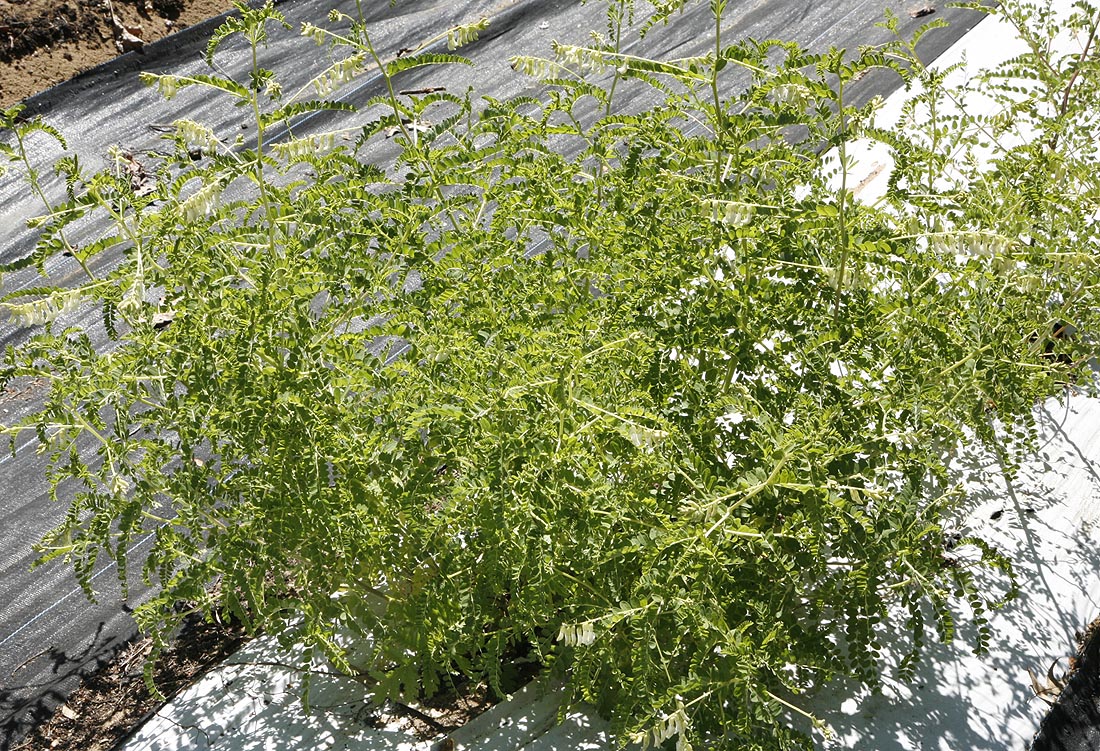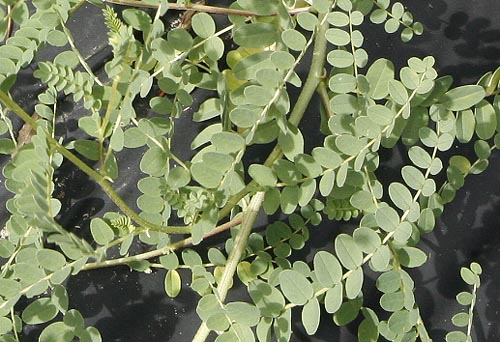Astragalus is a wonderful tough plant ideal for hot dry areas. It is a hardy perennial that dies down to its roots in winter and is hardy to - 20 °F (-28°C). Easy to grow from seed it needs a sunny location and well drained soil and does not really like to be watered much so it is ideal for those hot dry areas where nothing much else will grow. It has a sprawling habit, growing to about two feet in height. In early summer it produces multitudes of light cream flowers that will brighten any area. It needs no maintenance - except to clear away the dead branches before the next spring growth. Easy to grow, easy to maintain. Wildlife may eat it depending on your location. Butterflies and beneficial insects love the flowers.
Description of Chinese Milk Vetch (Astragalus Membranaceus).
A hardy perennial that dies back to the ground in winter. In spring it sends
up stout shoots that rapidly begin to branch forming a semi sprawling semi upright
shrub like structure about 2 feet (35cm) tall. The leaves are arranged alternately
on the hairy stems with each leaf being made up of 12 - 24 leaflets with the
total leaf length of 1-3 inches (3-6 cm).. Leaflets are arranged in pairs along
the stem and are oval with central vein and smooth edges. Leaves can be described
as fern like and are light to mid green in color up to 2 feet (60cm) in height
and easily as wide. During early summer the plant produces many long stemmed
flower spikes from the tops of the leaf axils. Each stem can be 14 inches (25cm)
long with the final 6 inches (15 cm) being the flower. The flower head is made
up of 15 -20 individual white or cream colored flowers that resemble pea flowers
(not surprising since Astragalus is part of the pea family). The individual
flowers are about ¾ inch (20mm) long tube like flaring at the end. All
the flowers hang on the same side of the stem. Flowers are followed by brown
puffy seed pods about 2 inches (5 cm) long that holds the kidney shaped brown
seeds. When in bloom the small bush can be festooned with flowers that can last
several weeks. Plants survive overwinter from their thick fleshy branching tap
roots. It is a native to China Mongolia and Korea.
Growing Chinese Milk Vetch (Astragalus Membranaceus) from Seed.
Astragalus seeds like lots of others in the pea family have a hard seed coating
and can benefit from some scarification before planting. Many sources state
that Astragalus should be scarified before planting. We never do this to our
plants we only soak them and get pretty good results this way.
Just soak them in water.
By far the easiest method is to soak the seeds in water overnight. This should
soften up the seeds and cause them to swell. We have found that this is usually
all that is needed to get the seeds to germinate well.
If some seeds have not swollen after this process then try scarifying only those.
Your fingers will thank you since it can be a awkward task.
If you really want to scarify (rough up the seed coating)
There is no really easy way to do this. Some people suggest putting them between
two pieces of sandpaper and rubbing, (I just get the skin rubbed off my fingers,
but the seed seems untouched) Others suggest using a knife. I never recommend
this method, these seeds are small and tough trying to nick them with a knife
is asking for perforated fingers and blood covered seeds. The best method I
have found if we have to scarify seeds is to use nail clippers. Even this is
not easy on something the size of a Astragalus seed. The trick is to hold the
seed in one hand and gently nick the seed coating with the clippers taking care
to ONLY nick the seed coating and not the inner seed. If you do this the seed
may be damaged and then fail to germinate.
Once seeds have been soaked remove them from the water and plant either two or three to a small pot or individual in peat pellet pots or medium sized plug trays. Keep moist but not wet until the seeds sprout. This can take 2-3 weeks depending on temperatures. When seedlings are large enough to handle pot into individual pots and grow on until large enough to harden off outside. For more information on seeding see our general growing instructions. Do not over water, Astragalus needs just moist not wet, overwatering is the most common reason these seedlings (and plants) die.
Location and Care of Chinese Milk Vetch (Astragalus Membranaceus).
Astragalus likes a sunny
location and well drained fairly dry soil. It is very
drought tolerant and can survive the heat quite well also. It can need some
extra water in times of drought but for the most part extra water may only cause
root rot. Astragalus is a very hardy plant and can survive up to - 20 °F
(-28°C). It does best on a sandy slightly alkaline soil but will grow in
almost any soil that is well drained. It will not tolerate any wet or moist
soils and the thick taproots will rot. Addition of compost is not recommended
unless the soil is extremely poor. Astragalus does well in fairly poor soil
and is very hardy.
When planting out ensure that each plant has about 2 feet of space around it
to sprawl into. These plants have taproots so try to transplant the whole plant
without disturbing the soil around the roots if possible. Either use peat pots
or wait until the roots just begin to show out the bottom of the pots before
transplanting the whole thing to its final location.
Astragalus does best if it is not disturbed once it has been planted, however
if necessary they can be transplanted but the plant could take at least two
years to re-establish itself and produce flowers after being moved. So pick
your location carefully so you don't need to move it.
Watering.
Most of the time the plants don't need water unless there is a heavy drought.
Be aware of this before adding water, as root rot and overwatering can cause
the leaves to wilt which can be mistaken for lack of water. In this case adding
more water just makes the problem worse and the plant dies.
No mulching!
Don't mulch around Astragalus plants and don't use wood chips or any kind of
mulch. If necessary use only a thin coating. The reason for this is that the
roots are very succulent and beloved by voles, gophers and other small rodents.
Mulch and ground coverings function as a highway for these animals to get to
your plants and eat the roots safely. Do keep the ground clear and your plants
will be safer.
Harvesting of Chinese Milk Vetch (Astragalus Membranaceus).
Roots are harvested for medicinal use after 4 years of undisturbed growth. In
good conditions the roots can go as deep as 4 feet so hand harvesting is necessary
and machines would miss most of the roots. Roots are harvested in fall after
growth has been completed for that year. Roots are usually washed and cut up
before drying.
Medical uses of Chinese Milk Vetch (Astragalus Membranaceus).
Astragalus is one of the most important tonic herbs used n Traditional Chinese
medicine. It is an adaptogen which means that it has a 'non specific' function
that normalizes the functions in the body no matter what the condition or disease.
It can help to strengthen the body against disease and is invaluable in working
with mental or emotional stress. It is high in anti oxidants and can help to
protect from free radical damage. It has been used for centuries to treat problems
such as Colds and influenza, Persistent infection, Fever, Multiple allergies,
Asthma, Chronic fatigue, Anemia, Wounds, Heart disease, Kidney disease, Hepatitis
and Stomach ulcers. More recently it is being used to treat AIDS and a lot of
potential for cancer treatment as well as Fatigue or lack of appetite associated
with chemotherapy.
Other names.
Huang-qi, Huang Chi,Huang Ch'i,Buck Qi,Yellow Leader, Milk-Vetch Root,Tragacanth,
Gum Dragon, Milk Vetch, Canada Milk Vetch, Membranous Milk Vetch, Slender Milk
Vetch, Standing Milk Vetch, Astragali, Huang Qi (Chinese), Beg Kei, Bei Qi,
Hwanggi. goat's horn, goat's thorn, green dragon, gum dragon, gum tragacanthae,
gummi tragacanthae, hoang ky, hog gum, huang-chi, Huang Qi, huangoi, huangqi,
hwanggi, ji cao, Leguminosae (family), locoweed,
membranous milk vetch, milk
vetch, mongolian milk, mongolian milk vetch, neimeng hhuangqi, ogi, ougi, radix
astragali, spino santo, Syrian tragacanth, tai shen, tragacanth, wong kei, yellow
vetch, Zhongfengnaomitong.









